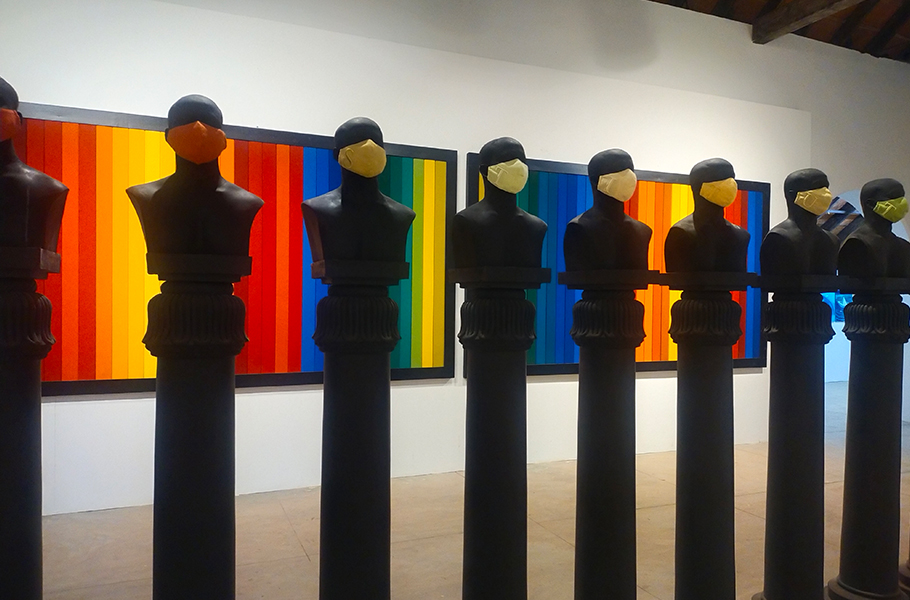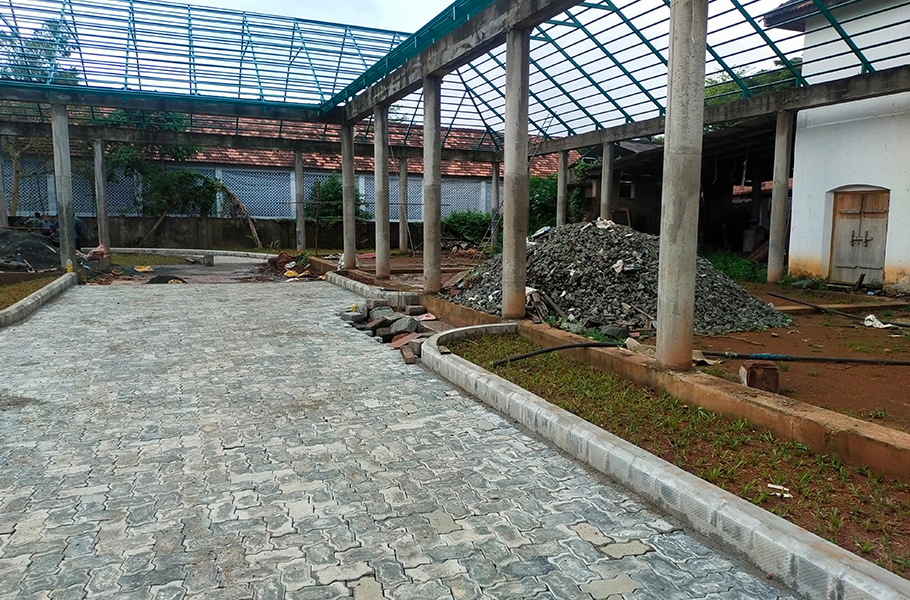
- Home
- IPL 2025
- The Great Language Divide
- News
- Premium
- THE FEDERAL SPECIAL
- Analysis
- States
- Perspective
- Videos
- Education
- Entertainment
- Elections
- Features
- Health
- Business
- Series
- Bishnoi's Men
- NEET TANGLE
- Economy Series
- Earth Day
- Kashmir’s Frozen Turbulence
- India@75
- The legend of Ramjanmabhoomi
- Liberalisation@30
- How to tame a dragon
- Celebrating biodiversity
- Farm Matters
- 50 days of solitude
- Bringing Migrants Home
- Budget 2020
- Jharkhand Votes
- The Federal Investigates
- The Federal Impact
- Vanishing Sand
- Gandhi @ 150
- Andhra Today
- Field report
- Operation Gulmarg
- Pandemic @1 Mn in India
- The Federal Year-End
- The Zero Year
- Science
- Brand studio
- Newsletter
- Elections 2024
- Home
- Delimitation Debate
- IPL 2025
- NewsNews
- Analysis
- StatesStates
- PerspectivePerspective
- VideosVideos
- Education
- Entertainment
- ElectionsElections
- Features
- Health
- BusinessBusiness
- Premium
- Loading...
Premium

How an art show is breathing new life into Alappuzha's decadent world

Ask any Malayali what he thinks of ‘Alappuzha’ – he will give you predictable descriptions. ‘Where the roads are waterways’, ‘the seat of the Leftist revolution’, ‘historic but not futuristic’ – in fact, anyone could easily ask what relevance can this old, decadent and dilapidated town have in a world where one’s life moves in the direction one swipes. But...
Ask any Malayali what he thinks of ‘Alappuzha’ – he will give you predictable descriptions.
‘Where the roads are waterways’, ‘the seat of the Leftist revolution’, ‘historic but not futuristic’ – in fact, anyone could easily ask what relevance can this old, decadent and dilapidated town have in a world where one’s life moves in the direction one swipes.
But Bose Krishnamachari would strongly disagree. As one of the founders of the Kochi Biennale Foundation teetering on the brink of financial collapse, deeply aware of the pandemic-wrought crisis on the international circuit and philosophically unenthusiastic of virtual art walk-throughs, Bose simply thought to himself – why not curate a contemporary art exhibition exclusively for Malayali artists?
“Creatively thinking, we can do an art show anywhere,” says Bose. “But a pragmatic plan rests on a single reality – space.” And Alleppey offered that in plenty.
“The State Coir Corporation’s warehouses and the Coir Society halls became this huge canvas right before my eyes – the image was so vivid and the impression so lasting that I could not think of any other venue more historically and philosophically time-bound.”
Lokame Tharavaadu (The World is Our Home), an art show comprising 267 artists, ‘who trace their roots back to Kerala’ thus arrived and there was no looking back.
For 30-year-old Mona S Mohan, this was her first major art show. Home-bound, devastated by the pandemic emotionally and financially, she took to weaving portraits on coarse kora cotton cloth with embroidery threads. “Our lives were a struggle. As artists, my husband and I wanted to be seen but we had zero opportunities. Then, the pandemic shut us down. He took to driving an autorickshaw to make ends meet.” The series, aptly called Game of Survival, has two life-size portraits hung like curtains facing each other. One is a self-portrait and the other is of the artist’s husband. “It was our struggle. So why not have our own faces in it? And I always liked to do portraits, only this time I experimented with sewing. My parents are tailors, I had plenty of threads and cloth lying around at home.”

Mona’s portraits can easily pass off as paintings seen from a distance, but a closer look reveals that those highlighted gradations of facial tones, those fine lines around the eyes and even that forlorn look of hopelessness have all been captured through ordinary embroidery threads.
Fifty-year-old Priti Vadakkath’s series of botanical drawings are a throwback to the pre-photographic ages where the need to scientifically document plant species demanded a pictorial illustration using water colours. “My drawings are not scientific because I’m not a botanist. Also, the size scale and composition of my works are vastly different from the book illustrations. My focus was on epiphytes – a species of plants that thrive by attaching itself to a host but unlike a parasite, it neither destroys, nor depletes, but nurtures and grows in harmony.”
As mother to a special child, Priti has always been partial to the theme of cohabitation. “A special child is different, but not separate. He may not be loud, flamboyant or brilliant. But the system needs him. He has a contribution too.” Her Conservatory series is unbelievably life-like, her passion for gardening clearly evident.
Sitting among jars of preserved body parts in a government forensic lab, 34-year-old artist Yamini Mohan did not consciously draw inspiration from her surroundings. “In retrospect though, my brief probationary stint with the Forensics Department had everything to do with my theme on display at Lokame Tharavaadu.” Around 15 charcoal drawings of nude and anatomical images of the body doubling up in pain, crouching in sorrow, submissive and weak – the message is deep without being disturbing. Titled ‘You are in Me’, these drawings have got people asking her – why can’t you draw something pleasant? “But I don’t see the erotic aspect, only the stark truth. The reality of having no control.”

‘Ummaram’ or front yard is that domestic space which prohibits movement for a certain kind of people. As 56-year-old artist Rathidevi explains, “We order them to stand in obeisance, step no further. The ummaram of a house is also the most neatly kept. It is a perpetual showplace with a fakeness to its neatness. It is also the place where your pets have a presence.” Animals are an oft-repeated theme in Rathidevi’s works as she strongly believes that humans cannot survive without them. “The sprawling front yards of ancestral houses are a thing of beauty – the creatures that cross it, the trees that contribute to the ground, unkept but alive, these spaces are slowly disappearing.”
The acrylic painting – an abstract expression of a ‘parambu’ adjoining a ‘mittom’ is stunning in its use of colour and vivid imagery. The orbs that take the place of flowers are actually ‘eyes’ like that of a cyclops. “What I’m trying to say is that whatever happens in the world, happens in your frontyard. And there are a million creatures watching.”
One of the most talked about series in Lokame Tharavaadu is Radha Gomati’s ‘Alexa! Win this War!’ – a series of 80-odd digital drawings of raw images, grotesque and serene, conflicted and peaceful at the same time. “During the pandemic, my little phone became my zone. I fooled around with a hand-written memo app and realised that it could be a medium for something else altogether.”
Radha’s drawings are people-centric. It has a victim of domestic abuse, the cash-cow Malayali nurse, the Nirbhaya rapist, brides in thorny tiaras and bleeding stigmata, couples in coital activity – the images, albeit violent and sexual, are also intense and rich in metaphor.
The exhibition, which began in April this year, was briefly interrupted by the lockdown imposed during the second wave of the pandemic. Given the amount of investment that has poured into setting up the venue and people’s rising interest in Lokame Tharavaadu the exhibition has received several extensions and is now supposed to go on till November 30.
The gender factor among Malayali artists
Of the 267 Malayali artists, 56 are women. Although the number does sound promising, female Malayali artists have a long way to go before they can establish themselves as serious artists. “I visited each artist to see their array of work,” says Bose. “Most women artists I met up with did not even have a room to keep their paintings, let alone a studio to call their own. For some, their kitchen table served as a working desk. For another, it was all stored under her bed.”

“Everyone claims there is no gender disparity in art but that is far from being true,” says Gomati. “Ageism is a reality. Promoting a younger artist makes much more economic sense. Why invest money on a veteran? Artists aged less than 35 years have a stronger support system, and a louder presence on social media. But a woman artist’s life begins at 40. At mid-life, not mid-career, is when she needs the biggest support. And to arrive at the table of merit, she has to surmount umpteen obstacles. So many have fallen along the way. It is a miracle to survive in this industry.”
Sustained concentration is only a myth, especially for women artists. “I have lost so many years in between”, says Yamini.
“Sometimes we women artists are forced to choose an alternative career that brings food to the table, pays our bills,” says Rathidevi.
Marriage, motherhood, relocation are the other reasons.
There are only two ways to get your work noticed, says Bose. First is being a participant at a Biennale – the invitation by itself is an acknowledgement and an entry into a new order. Second is being discovered by a reputed gallery. But for women artists who unwittingly have career lapses, both these options don’t help much.
“It’s amazing to see the range of work of the Malayali women artists – from surreal magic to brilliantly abstract. Some are extremely well-educated from the finest of art schools, while artists like Shanta CM and Smitha GS are self-taught, subconsciously drawing from various schools of art.”
Kerala, according to Bose, has the best talent in the country but it’s always the emigrant artist who survives, the local continues to lack exposure and opportunity. For instance, while Bengali artists have enjoyed the patronage of Indian billionaires for years, one rarely sees that kind of support for the resident Malayali.
Which makes this exclusive art exhibition Lokame Tharavadu an event that should have happened long ago.
“The Kochi Muziris Biennale was the limousine that did not stop at our houses. But Lokame Tharavaadu is giving us a lot of hope. However, it’s too early to say how much of this will help the woman artist in Kerala.”
So far, the exhibition has sold artwork worth approximately a crore. With a month and a half left, the organisers are hoping to sell more. If that happens, it’s a win-win for everyone. And the town of Alappuzha, just maybe, will not fit the most damning of descriptions – an antonym for progress.
(Author is a Kerala-based journalist.)
